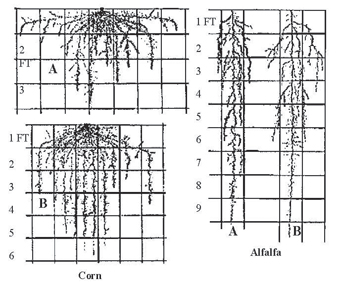G896
Management to Minimize and Reduce Soil Compaction
This NebGuide will help you understand how natural processes and management practices can reduce existing soil compaction and minimize its further development.
Charles S. Wortmann, Nutrient Management Specialist
Paul J. Jasa, Extension Engineer
Nature has built-in processes that reduce soil compaction, including cycles of wetting and drying, freezing and thawing, as well as plant growth and microbial activity. In the last 30 to 40 years, farming practices have changed drastically, creating situations where natural rejuvenation of the soil environment by wet-dry and freeze-thaw cycles is inadequate to maintain optimum conditions for crops. Performing field operations on wet soils, using multiple field operations for crop production, eliminating perennial crops from crop rotations, and using heavy equipment contribute to more extensive and deeper compaction.
Soil compaction problems can be reduced or eliminated through use of proper management practices.
Management Strategies
Stay Off Wet Soils
Soil is most susceptible to compaction when soil water in the 3- to 6-inch soil depth is near field capacity or wetter. Under such moisture conditions, the potential for compaction increases as soil clay content increases and soil organic matter decreases.
The water content of a soil can be determined using the feel-and-appearance method, or by molding soil from the 3- to 6-inch depth and dropping the soil ball onto a hard surface; if it does not break or crack on impact, it is too wet for field operations.
Perform field operations in your driest fields first to allow more drying time for wetter fields. If field operations need to be conducted when the soil is near field capacity to remain timely, minimize the axle load and increase tire size to reduce deep compaction. Larger tires will compact more of the soil surface, but with less pressure on the soil and less penetration of compactive forces.
Reduce Tillage
Tilled soils are more susceptible to compaction than no-till soils. Tillage contributes to the breakdown of soil structure by compressing and breaking soil aggregates, which are necessary for good air and water movement and good root growth. Tillage also results in the loss of soil organic matter which is important to soil aggregate stability. Reduced tillage systems leave greater amounts of plant residue on the soil surface which helps prevent surface sealing, a form of compaction, by intercepting raindrops before they hit the soil surface.
Tillage affects microbial activity in the soil. Reduced tillage causes fungal decomposers of organic matter to increase relative to bacterial decomposers. Fungal, as compared to bacterial, decomposers aid aggregate formation and stability on fine-textured soils.
Build Soil Organic Matter
|
Organic matter promotes the development of good soil structure and decreases soil bulk density. It helps bind soil particles together as aggregates so they are not as easily cracked, split, or compressed by tillage or wheel traffic. Root derived organic matter is especially effective in aggregate formation. Building soil organic matter also increases soil nutrient mineralization and availability for crop growth, especially for nitrogen, phosphorus, sulfur, and trace elements.
Organic matter can be added to the soil in the form of animal manure, municipal biosolids, or green manure crops, and by leaving crop residues in the field. Tillage generally accelerates the decomposition of soil organic matter.
Rotations with Perennial Crops
When crop rotations include alfalfa, clover, or grass, soils usually are less compact than soils in fields without these rotations. This is true as 1) there generally is no tillage for several years after seeding, 2) trips across the field tend to be associated with hay harvesting when the soil is dry and less susceptible to compaction, 3) the deeper rooting depth and large taproot of alfalfa and clover keeps the soil more porous (Figure 1) and 4) these crops remove large amounts of water which helps dry the soil and increase cracking in some soil types.
Alter the Tillage Depth
If you till the soil, vary tillage depth to minimize the development of a “tillage pan” or compacted zone where the tillage implement shears the soil. Till deeper in dry years when soil fracturing is greatest. Keep tillage shallow in wet years to avoid formation of a deep tillage pan. Shallow pans can be easily fractured with tillage when the soil is dry.
Control Wheel Traffic
Compaction will be intense but localized if all equipment wheel traffic is restricted to “tracks” or traffic lanes in the field, while the nontraffic areas are protected from compaction (Figure 2). The area in traffic lanes is minimized when the operating widths and wheel bases of various implements are well matched. Farm implements have different wheel widths making it difficult to confine traffic. Traffic control is easier with fewer operations such as with ridge plant and no-till systems. Planning is required in equipment purchase or hire to reduce the variability in wheel track requirements. Table I gives suggested wheel spacings and estimates of wheel traffic compaction for various equipment sets. Infield operation on moist soils, such as with grain carts, may be reduced to minimize compaction.
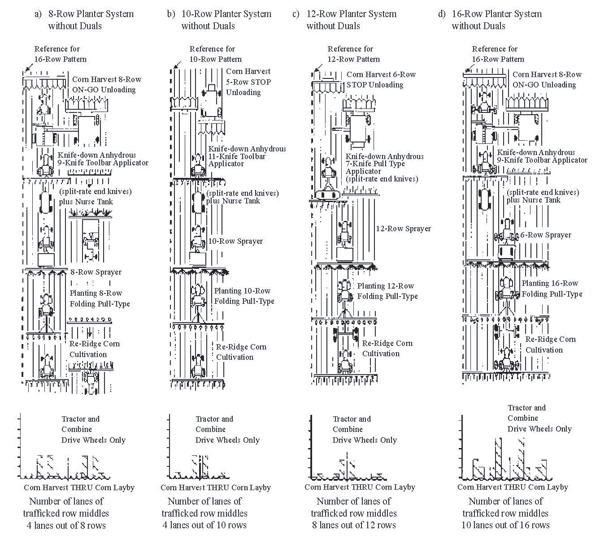 |
| Figure 2. Traffic lane patterns to minimize field area affected by compacting forces. |
|
|||||||||||||||||
Deep Tillage
Compaction causes reduced yields and may worsen other problems that reduce yields, such as disease and low nutrient supply because of reduced root distribution. Assessment of the severity of compaction problems is best done by inspection of crop roots. If root growth is restricted due to compaction, deep tillage such as subsoiling may be warranted.
The depth of yield-limiting soil compaction will determine the required depth of tillage and tillage tool selection. If compaction occurs in the top 6 to 8 inches of the soil, tillage tools such as a chisel plow or moldboard plow can be used to shatter the compacted layer (Figure 3). However, if compaction is below 8 to 10 inches, tillage tools such as a subsoiler, ripper, or paraplow may be needed (Figure 4).
Many types of subsoilers are available. Most are chisel-like tools having curved or straight shanks. Each shank will require at least 20 to 30 PTO horsepower for deep tillage. Subsoiling depth should be 50 percent deeper than the compacted layer with shank spacing equal to the tillage depth for greatest shattering; however, tillage at this depth has a high power requirement which quadruples as tillage depth is doubled. An alternative is to operate the subsoiler 1 to 2 inches below the compaction layer with shanks spacing equal to the row spacing (Figure 5). The compacted zone will be most shattered, in a V-Shaped pattern, when the soil is dry to the tillage depth. Subsoiling tillage is often best performed in the late summer or fall, but can be done whenever the soil is dry enough. The relative success of subsoiling will vary with soil type, soil water content, soil texture and bulk density, and the shape of the subsoiler shank. To ensure that the compacted zone has been shattered properly, dig a hole and look for the V-Shaped wedge of loosened soil.
“Slot ripping” allows roots and water to penetrate into the soil, especially if the rows of the next crop follow the slots (Figures 5 and 6). Parabolic shanked subsoilers heave the soil surface too much to allow slot planting of the next crop. Secondary tillage may be used in the spring to level the field prior to seeding but subsoiled fields can redevelop a compacted layer if the loosened soil is worked when wet or if wheel traffic is not controlled. Soil heaving and the need for secondary tillage to smooth the field can be reduced by using a coulter in front of a straight legged subsoiler shank.
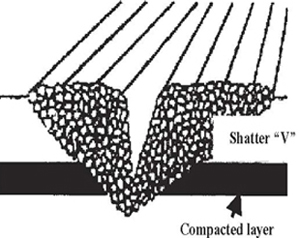 |
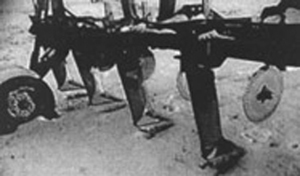 |
| Figure 3. A chisel shank shatters a V-Shaped section of soil from the base of the shank upward toward the soil surface. | Figure 4. Deep tillage can be performed with a subsoiler (shown) or other implement depending upon the depth of compaction. |
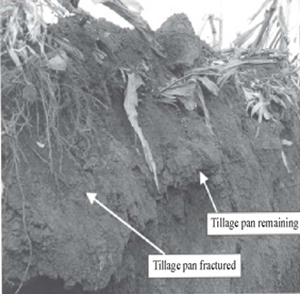 |
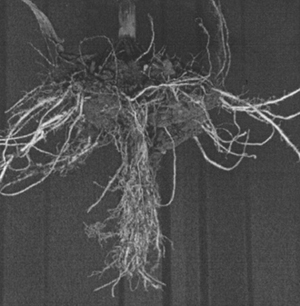 |
| Figure 5. An example of the V-Shaped fracture from a ripper shank operating in dry soil. The field was slot ripped the fall before and the current crop was no-till planted above the slots. Portions of the tillage pan remain between the rows. | Figure 6. The corn roots grew in the loose soil above the tillage pan and down through the slot cut in a severely compacted tillage pan. This soil was wet when slot ripping and the shattering of the pan was much less than desired. |
Summary
Most important is to manage land to minimize soil compaction and avoid problems with deep compaction. Most cropland in Nebraska should never require deep tillage if well managed. When it is necessary to subsoil, rip, or slot rip due to deep compaction, deep till when the soil is dry to shatter the compacted layer.
This publication has been peer reviewed.
Visit the University of Nebraska–Lincoln Extension Publications Web site for more publications.
Index: Soil Resource Management
Compaction
1989, 2003, Revised October 2009
